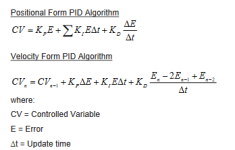Why??? My guess is its because that's what your most familiar with. Because it surely cannot be for performance, price, scalability, flexibility. I know it's not for those reasons, can't be.
20 years ago.....
I was rolling with a new flip phone that had this cool new feature where they integrated a camera into the phone. Imagine that, a camera
in the phone! It was great because you could take pictures with your phone and display them on the little screen on the phone!
Apple had this really cool product too, called an 'Ipod'. It was actually a portable HDD that could store up to 5000 songs on it!!! Bye-bye Walkman portable CD player! You had be careful carrying it around though because it was not a solid state drive, so a hard bump would make the song skip. It was a bit big and clunky too, but I still managed to get the thing in my front coat pocket.
Sarcasm aside, the point is
a lot has changed in the past 20 years. Don't tell me about 20 years ago. The automation industry landscape is changing.
BMW
Toyota
It's price... and I don't mean purchase price but rather total cost of (lifetime) ownership.
I was a Fanuc and Rockwell (generally combined) integrator for about a half decade... I had a hard time understanding why customers wanted to spec everything about what we did in controls. I felt I was being constrained by legacy gear in some situations, and software architecture in others.
And then I went back to (no travel!!) work at a local (huge) mill. This mill has equipment that has been running, in some areas, since the late 80s / early 90s. There are about 100-110 PLCs here. The entire electrical department is 10-11 guys currently. 7-8 of them have been here for >20 years. You may not like to hear this (you said you didn't) but it's real life reality in many places. They can support the PLC5 and SLC based equipment very well. It becomes tenuous as we get into Logix5000 (AOIs; etc) and impossible when they have to jump over to the 2-3 PLCs that are Mitsubishi, for example, or even Logix5000 that is done in FB and/or ST.
Given the high cost of down time and the ability of the electricians here, if machines were still sold with PLC5 hardware, they would honestly consider it.
We really don't care about what makes the integrator's life easy because 1. he's getting paid and can bill for our requirements (as I did when I was an integrator) and 2. He will not be in this plant to support his baby for the next 30 years after it is born. It takes very few hours of production downtime to justify getting the hardware / software that the local group is already familiar with, up front. It's basic business. This mill is in a remote facility and it is very hard to attract new (and ABLE!) talent. 45 minutes away, you can work at several Amazons and dozens of other huge name manufacturers, so trained and able help will often leave for greener grass.
A good example of this... I did 4 palletizing 410 robots with a sorting infeed and a full pallet wrapper that went to a GE facility that produced lightbulbs. Part of their spec included using GE PLCs. It was their name and they had a plant full of them. I advised them that (PLC) development time would reach 3x that of Rockwell and I got the answer that I myself gave above; "the cost up front matters little when you are honest about the total cost of ownership of the machine". They had a crew that knew GE PLCs inside and out (must have been in-house trained haha). They also specified ladder with EVERY rung commented in a way that explained what it did. They understand the work and that it would cost more like that (take longer), but they recognized the savings in support time. We built what they wanted, even having never touched a GE PLC previously (nor since lol).
I'm fighting tooth and nail to keep a Beckoff machine out of the plant now, because it will be the only one here. Out of the 500+ people that work here, there is no one with even exposure to Pascal / ST besides myself, and the new machines are all ST. Our guys can very easily use ladder for machine troubleshooting. None of them will be able to say the same about Beckoff.
So yeah.... your ipod is a great step-up from a Walkman/Discman for sure. But what if you had no computer (or ability) to use with it. If you had 500 CDs but were MP3 'tarded (and with no computer) then you really needed a new Discman to continue listening.
I think a lot of integrators have lost sight of this, or never had it to begin with. It's great that you love ST and can see the power of using it. It's unhelpful for a great many users that have supported ladder for decades though, and this is very often the reality.
That's my 2 cents. I'm not anti-any-brand but for ease of support, I will pick what the base here is already able to properly support.







